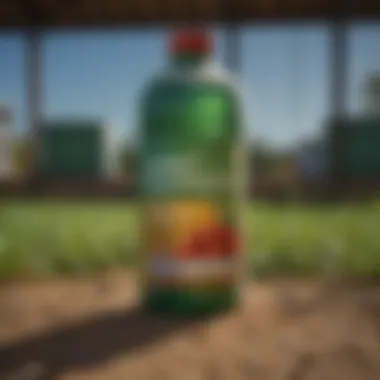Essential Training for Certified Paraquat Applicators


Intro
Paraquat dichloride is a powerful herbicide commonly used in agriculture, providing effective weed control under certain conditions. However, its use comes with significant risks and regulatory concerns. Certified applicators must undergo comprehensive training to ensure safe handling and application. This training not only emphasizes safety protocols but also highlights the importance of adhering to legal guidelines. The goal is to improve competency among agents who deal with this toxic substance in their work.
Current Trends in Agriculture and Horticulture
Overview of Recent Innovations
Recent innovations in agriculture focus on enhancing efficiency while minimizing environmental impact. Precision agriculture is one of these trends, relying on technology to optimize field-level management regarding crop farming. This approach involves using data analysis and monitoring to apply herbicides like paraquat dichloride accurately. By applying herbicides only where needed, farmers can reduce waste and limit chemical exposure to the environment.
Sustainable Practices Gaining Popularity
Sustainability is increasingly important in modern agriculture. Many farmers and applicators are adopting integrated pest management (IPM) practices. These practices aim to minimize chemical use by incorporating biological pest control and crop rotation. Training for paraquat application must address these sustainable methods. Understanding the interaction between chemical and ecological health allows for better decision-making and effective use of paraquat dichloride within a broader IPM strategy.
Essential Farming Techniques
Soil Health Management
Healthy soil is the foundation of productive farming. Training programs should include soil health management techniques. Topics may cover soil testing, organic amendments, and crop cover systems. Healthy soil can improve water retention and nutrient availability, making crops more resilient to pests and diseases. Certified applicators must understand how paraquat can affect soil biota and integrate it well within established soil health practices.
Pest and Disease Control Strategies
Control strategies must be multifaceted. Reliance solely on chemical herbicides can lead to resistance among weed populations. Training programs should incorporate pesticide rotation strategies and alternative control methods. Application techniques can significantly affect efficacy and environmental outcomes. Knowledge about timing, dosage, and application methods is critical for successful pest and disease management while using paraquat dichloride.
Tools and Technology in Farming
Overview of Advanced Farming Tools
Modern tools enhance the way applicators interact with herbicides. Tools like drones enable precise application, reducing overspray and targeting weeds efficiently. These methods can considerably lower the amount of paraquat needed for effective application. Training should encompass these technological advancements, ensuring applicators are adequately prepared to use them safely and effectively.
Case Studies on the Use of Technology
Analyzing the impact of technology is essential for understanding its benefits in herbicide application. Case studies can demonstrate successful outcomes from technology integration. For example, a farmer who used drone technology for paraquat application reported decreased herbicide usage while maintaining weed control. Sharing such case studies during training can motivate applicators to adopt new methods.
"In agriculture, knowledge is a powerful asset. Understanding paraquat dichloride’s role in modern practices enhances both safety and effectiveness."
Preface to Paraquat Dichloride
Paraquat dichloride is a critical herbicide used extensively in the agricultural sector. Understanding its properties and applications is not only important for effective farming practices but also essential for safety and regulatory compliance. This section delves into the definitions, composition, and historical context of paraquat, offering a foundation for certified applicators.
Definition and Composition
Paraquat dichloride is a contact herbicide primarily used to control annual weeds and grasses. Its chemical formula is C124Cl2N, and it operates by disrupting the photosynthesis process in plants. Paraquat is a quaternary ammonium compound, known for its fast-acting nature and effectiveness against a variety of weeds. Given its potency, the composition of paraquat means that even minimal exposure can have significant effects, making it crucial for applicators to understand its active components.
Notably, paraquat formulations generally contain a range of surfactants and solvents, which aid in proper application and improve herbicide effectiveness. As such, comprehension of the composition enables users to follow proper application procedures, ensuring both optimum results and safety.
History of Use in Agriculture
Paraquat dichloride was first registered for use in the late 1960s. Its adoption in agriculture coincided with the rising demand for effective herbicides capable of managing persistent weeds. Over the last few decades, paraquat's use has expanded globally due to its reliability and faster action compared to other herbicides.
Historically, it has been popular among farmers for its ability to control various difficult-to-manage plants while requiring less quantity compared to alternatives, thus saving costs. However, this widespread usage has brought about concerns regarding safety and environmental impact due to its toxicological profile. Regulatory bodies have responded by establishing stringent guidelines surrounding its application and use, emphasizing the need for proper training among certified applicators.
Overall, understanding the historical context of paraquat informs current practices and underscores the necessity for comprehensive training in its application.
Importance of Training for Certified Applicators
The application of paraquat dichloride requires a high level of precision and awareness, making training imperative for certified applicators. Proper training ensures that applicators understand the complexities of this substance and adhere to guidelines that govern its use. This section examines various elements that highlight the significance of training in this context.
Regulatory Compliance


Certified applicators must comply with strict regulations set by national and international authorities. These regulations are designed to ensure safe handling and application of paraquat dichloride. Training programs equip applicators with the knowledge necessary to navigate these regulations effectively. Compliance reduces the risk of legal issues and potential fines, which can occur if applicators fail to adhere to guidelines.
Understanding the regulatory landscape helps applicators know what is required for safe use. For instance, the Environmental Protection Agency (EPA) has outlined rules that impact how paraquat is applied. These rules include label requirements, application sites, and protective equipment. Training ensures that applicators are familiar with these details. This knowledge is crucial for maintaining operational licenses and ensuring public and environmental safety.
Risk Mitigation
Another vital component of training is risk mitigation. Paraquat dichloride is a potent herbicide with well-documented health risks. Without adequate training, applicators may inadvertently expose themselves or others to harmful situations. Training programs address the potential health hazards, emphasizing the importance of using personal protective equipment and following safety protocols.
Risk mitigation training often includes practical exercises such as:
- Proper mixing procedures to avoid spills.
- In-field safety measures to limit exposure.
- First aid responses in case of accidents.
Addressing these aspects not only protects the applicators but also minimizes the risk posed to nearby communities and the environment. Knowledge gained through training reduces the incidence of accidents and enhances the overall safety landscape in agricultural practices.
Understanding the Risks Associated with Paraquat
The proper handling and application of paraquat dichloride is essential for certified applicators. The understanding of its risks forms the basis of the training necessary to ensure safe usage. Knowledge of toxicological factors, potential health hazards, and environmental impact influences the decision-making process in agricultural settings. Awareness of these risks enables applicators to mitigate dangers effectively, reducing the likelihood of incidents that can affect their health and the ecosystem.
Toxicological Profile
Paraquat dichloride is a highly toxic herbicide, primarily known for its rapid action in controlling weeds. Its mode of action involves the generation of reactive oxygen species, leading to cell death in plants. The chemistry of paraquat reveals its systemic properties and affinity for binding to plant cell membranes. While its efficacy in agriculture is well acknowledged, this potency comes with significant risks. Even small doses can be lethal to humans, making it critical for applicators to comprehend the substance's toxicological profile.
Factors such as absorption rates, distribution in the body, and potential for bioaccumulation should be discussed during training sessions. Understanding these characteristics encourages responsible handling and application.
Potential Health Hazards
For those who work with paraquat, the potential health hazards are profound. Exposure through inhalation, dermal contact, or ingestion can result in acute poisoning. Symptoms may include nausea, vomiting, and in severe cases, pulmonary edema and multi-organ failure. Long-term exposure raises concerns regarding chronic health issues, including neurological damage and implications for reproductive health.
To mitigate these risks, training must focus on:
- Use of personal protective equipment (PPE)
- Proper storage and disposal methods
- Recognizing symptoms of exposure
Extra precautionary measures must be emphasized during training. The severity of paraquat's health risks beckons a thorough understanding of the safety protocols.
Environmental Impact
The environmental implications of paraquat usage merit attention from applicators. Once applied, paraquat can drift from targeted applications, impacting non-target plants and surrounding soil. It poses significant risks to aquatic ecosystems if it enters waterways. Understanding its degradation process—and the factors affecting its breakdown—is vital in minimizing ecological footprints.
Farmers and applicators should consider embracing integrated pest management practices. This holistic approach can effectively reduce reliance on harsh chemicals like paraquat, ultimately leading to more sustainable agriculture. The training should underscore the responsibilities of certified applicators in protecting biodiversity while ensuring effective weed management.
"The risks of paraquat are not only immediate but can echo through future generations and ecosystems."
Overall, understanding the risks associated with paraquat is fundamental for certified applicators. This knowledge enables informed and responsible practices while emphasizing the importance of ongoing education and training in agricultural safety.
Training Components for Certified Applicators
Effective training components are vital for certified applicators of paraquat dichloride. This herbicide is powerful and poses various risks. Thus, robust training ensures that applicators understand the product, its uses, and the necessary safety protocols. The training not only aids in proper handling and application techniques, but it also aligns with regulatory requirements. Properly trained applicators contribute to overall agricultural safety and environmental protection.
Introductory Modules
Introductory modules form the foundation of the training program. These modules cover essential topics such as the chemical properties of paraquat dichloride, its classifications, and its actions as a herbicide. Information on the legal regulations surrounding the use of paraquat is also crucial. Applicators should be familiar with the Material Safety Data Sheets (MSDS) that detail product hazards, handling procedures, and emergency procedures. Understanding these basics is essential for safe practice.
Application Techniques
Correct application techniques significantly affect the success of herbicide treatments. Training should include various methods of application such as spraying, granulation, and soil incorporation. Applicators must learn to calibrate equipment effectively to ensure proper dosage. Explaining drift management is also crucial to minimize unintended exposure. This can include understanding environmental conditions that may affect spray patterns. Applicators should practice using real scenarios to boost their confidence and competence in applying paraquat dichloride.
Safety Protocols
Safety protocols must be integral to any training program. Applicators should be educated on personal protective equipment (PPE). This includes gloves, masks, goggles, and coveralls during application. Training should also emphasize the importance of hygiene practices, such as washing hands before eating or drinking. These precautions reduce the risk of exposure significantly. It is also essential to discuss the importance of keeping a first-aid kit accessible and knowing how to use its contents appropriately.


Emergency Response Procedures
Lastly, it is crucial for certified applicators to learn emergency response procedures. They must know the proper actions to take in case of accidental exposure or spills. Training should encompass how to handle various scenarios, such as chemical exposure or contamination of equipment. An effective way to prepare applicators is to conduct simulations of emergencies. Understanding the local emergency contact numbers and procedures is also essential. This training ensures that applicators can respond swiftly and efficiently to potential incidents, safeguarding their health and the environment.
"Comprehensive training enhances understanding and minimizes risks associated with paraquat dichloride use."
Conducting Effective Training Sessions
Conducting effective training sessions is vital for certified applicators of paraquat dichloride. These sessions not only impart essential knowledge but also ensure that applicators understand the implications of their actions in the field. With the complexity surrounding paraquat and its usage, effective training can lead to improved safety, increased compliance with regulations, and enhanced precision in application techniques. It is critical that each training session is strategically designed to meet the varying needs of participants, taking into account their previous experience and knowledge level.
Designing the Curriculum
Designing a comprehensive curriculum is the first step in conducting effective training sessions. The curriculum must address all relevant aspects of paraquat dichloride, including toxicology, safe handling practices, and application methods. A well-structured curriculum integrates theoretical knowledge with practical exercises. This combination ensures that participants can relate what they learn to real-world applications.
Some specific elements for a well-rounded curriculum include:
- Regulatory Information: Understanding federal and state regulations about paraquat.
- Risk Assessment: Identifying potential hazards associated with paraquat.
- Application Techniques: Training on the proper methods for applying herbicides effectively.
- Safety Protocols: Emphasizing the importance of personal protective equipment (PPE) and emergency protocols.
A thoughtfully developed curriculum not only prepares participants for safe application but also enhances their confidence in managing this potent herbicide.
Instructional Methods
The choice of instructional methods directly influences the effectiveness of training sessions. Utilizing a variety of teaching techniques can cater to different learning styles and maintain participant engagement.
Among the recommended instructional methods are:
- Lectures: For delivering foundational knowledge on paraquat dichloride and its applications.
- Hands-on Training: Providing opportunities for participants to practice application techniques in a controlled environment.
- Group Discussions: Facilitating sharing of experiences and insights among participants, fostering a collaborative learning atmosphere.
- Multimedia Presentations: Using videos and slideshows to illustrate complex concepts can enhance understanding.
These diverse methods encourage interaction, making the training sessions more dynamic while improving information retention.
Assessment and Certification
To ensure the effectiveness of training, assessment and certification procedures must be implemented. This not only evaluates participant understanding but also establishes accountability. Assessments can take various forms, such as quizzes, practical evaluations, or scenario-based exercises.
Key points for effective assessment and certification include:
- Clear criteria for evaluation.
- Regular feedback for participants.
- Opportunities for retesting or additional training if necessary.
Certification upon successful completion is essential; it validates the knowledge and skills of the certified applicators, enhancing their credibility in the field. By closing the training loop with assessment, trainers ensure that participants are not only knowledgeable but also competent in safe paraquat application.
Case Studies on Paraquat Application
Understanding case studies on paraquat application is essential for effective training. These studies provide real-world examples that showcase both successes and failures, which can be instructive for certified applicators. They highlight important considerations in handling, application techniques, and safety protocols. The information derived from these cases helps in preparing applicators for varying scenarios they may face in the field.
Successful Implementation
Successful implementation of paraquat often relies on comprehensive training. For example, a farm in the Midwest may have adopted advanced application techniques leading to increased crop yields while minimizing herbicide drift. This case demonstrated the value of precise timing and calibration in application machinery, ultimately resulting in a more efficient use of resources. Proper training ensured that the applicators understood how to monitor environmental conditions like wind direction and speed, which are critical when applying paraquat.
"Proper handling and application of paraquat can yield significant benefits in agricultural production, as evidenced by successful case studies."
Several farms that adopted rigorous training protocols for their workers reported reduced incidents of accidental exposure. Training programs included modules on equipment operation and maintenance, as well as safety gear usage. Over time, these practices led to safer working environments and better adherence to regulatory requirements.
Lessons Learned from Incidents
Incidents involving paraquat have pointed out the vital need for structured training. For instance, there were cases where a lack of proper training led to emergency situations. In one incident, an applicator misread the product label, applying the herbicide at twice the recommended dosage. The results were detrimental, not just to the vegetation intended for treatment but also to nearby crops and wildlife.
Such incidents underline several key lessons:
- The critical importance of understanding product labels and safety instructions.
- The need for continuous education on the evolving regulations surrounding chemical applications.
- The value of immediate reporting and response procedures in case of accidental exposure.


Reviewing these lessons can guide trainers in developing curriculums that encompass not only effective application methods but also responding to unexpected situations. The cases provide valuable insights that can enhance the training framework for certified applicators, ultimately ensuring safer and more effective use of paraquat.
Regulatory Framework Surrounding Paraquat
The regulatory framework surrounding paraquat dichloride is critical for ensuring the safe handling and application of this potent herbicide. As a certified applicator, understanding these regulations is not just important for legal compliance, but also for promoting environmental stewardship and safeguarding public health. The framework establishes standards that applicators must adhere to, which encompass product registration, labeling, and usage practices. By respecting these regulations, applicators contribute to the sustainable use of paraquat in agriculture, minimizing risks associated with its toxicity and ensuring the safety of surrounding ecosystems.
National Regulations
National regulations regarding paraquat usage differ across countries, but many share similar principles. In the United States, for example, the Environmental Protection Agency (EPA) oversees the registration process for pesticides, including paraquat dichloride. This process evaluates the safety and efficacy of the herbicide before it can be marketed for agricultural use.
Key points regarding national regulations include:
- Labeling Requirements: Each paraquat product must have an approved label detailing usage instructions, safety precautions, and emergency procedures. Applicators are legally required to adhere to these instructions closely.
- Restricted Use Pesticide (RUP) Classification: Paraquat is classified as a Restricted Use Pesticide due to its high toxicity. Only certified applicators can apply paraquat, ensuring that knowledgeable individuals handle it.
- Record Keeping: Applicators must maintain records of paraquat use, including quantities applied, locations, and dates. Such documentation is vital for compliance checks and audits by regulatory bodies.
By following these regulations, certified applicators not only comply with the law but also help protect themselves, others, and the environment from the possible adverse effects of improper usage.
International Guidelines
Internationally, guidelines for paraquat use aim to harmonize safety standards and promote best practices across borders. Organizations such as the World Health Organization (WHO) and the Food and Agriculture Organization (FAO) provide frameworks designed to guide the safe application of pesticides.
A few notable international guidelines include:
- WHO Recommended Classification: This classification system categorizes pesticides based on their potential hazards to humans and the environment, helping applicators understand risk levels associated with paraquat.
- FAO Code of Conduct: The FAO encourages responsible pesticide management, urging countries to implement regulations that minimize health risks and environmental impact.
- Global Harmonization System (GHS): The GHS aims to standardize chemical hazard communication, including labeling requirements for paraquat and other pesticides, ensuring clarity and consistency worldwide.
By adhering to these international guidelines, countries can work toward reducing the risks associated with paraquat application and foster safer agricultural practices globally.
Future Trends in Paraquat Use and Training
The landscape of agriculture is ever-evolving. As farms become more reliant on technological advancements and best practices, the discussion surrounding paraquat dichloride must also adapt. This section explores recent trends and future directions for paraquat usage and training protocols. This is vital not only for ensuring continued compliance but also for advancing safety measures and overall efficacy in application strategies.
Research and Development
Innovations in the formulation and application of paraquat are essential for maximizing its effectiveness while minimizing risks. Ongoing research is focused on several key areas:
- New Formulations: Scientists are exploring new chemical formulations that may increase the herbicide’s efficiency and limit environmental impact.
- Application Technologies: Advances in application technologies such as drone spraying and precision agriculture can potentially enhance the way paraquat is applied. This can ensure targeted delivery that reduces waste and mitigates harm to non-target species.
- Resistance Management: There is a growing concern about weed resistance to herbicides. Research is directing efforts towards combining paraquat with other control methods to manage this resistance. This not only preserves the utility of paraquat but also ensures sustainable agricultural practices.
Ongoing research and development are crucial in creating safer and more effective usage of paraquat in agricultural fields.
Sustainable Practices
The future of paraquat usage must consider sustainability. The agricultural sector is increasingly aware of its responsibility towards the environment. Sustainable practices with paraquat can improve long-term viability in farming operations. Some relevant considerations include:
- Integrated Pest Management (IPM): Farmers are encouraged to adopt IPM strategies that integrate the use of paraquat with other pest management techniques. This minimizes reliance on any single chemical and promotes ecological balance.
- Educational Initiatives: Educational programs focusing on sustainable use of paraquat are essential. Training should cover best practices in application to ensure minimal environmental exposure and promote safety among workers.
- Regenerative Agriculture: Concepts like regenerative agriculture advocate for practices that restore soil health and biodiversity. Using paraquat in a way that contributes to these goals will likely become a priority to maintain soil integrity and encourage diverse ecosystems.
Finale
In this article, the significance of comprehensive training on paraquat dichloride cannot be understated. The use of this herbicide in agriculture introduces various risks. Thus, structured training programs are necessary for certified applicators. They ensure not only compliance with regulations but also the safety of users and the environment.
Recap of Key Points
Revisiting the essential aspects we discussed reveals multiple layers to effective training:
- Regulatory Compliance: Understanding national and international laws helps applicators stay within legal guidelines.
- Safety Protocols: Knowledge about personal protective equipment (PPE) and safe handling enhances safety in application.
- Application Techniques: Proper methods reduce waste and improve efficacy in crop management.
- Emergency Response Procedures: Preparedness for incidents safeguards health and mitigates environmental damage.
This recap highlights the complexity of working with paraquat dichloride. Each element plays a crucial role in an applicator's success.
Call to Action for Continued Education
Continued education is paramount for anyone involved in the use of paraquat dichloride. The agricultural sector is continually evolving. New research, regulations, and safety standards emerge regularly. Therefore, certified applicators must engage in ongoing training programs. This will strengthen their knowledge and ability to manage the risks associated with paraquat.
Investment in education translates to:
- Improved safety and health outcomes.
- Greater awareness of environmental impacts.
- Enhanced operational efficiency in agricultural practices.
Make a commitment to seek out updated training. This will ensure the responsible use of paraquat dichloride and contribute to sustainable agricultural practices.



